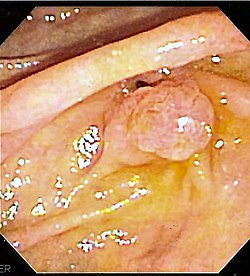| Ampulla of Vater | |
|---|---|
 A diagram of the biliary system. Note that the ampulla of Vater is behind the major duodenal papilla. | |
 The major duodenal papilla, seen on duodenoscopy at the time of ERCP. This is the protrusion of the ampulla of Vater into the duodenum. | |
| Details | |
| Identifiers | |
| Latin | ampulla hepatopancreatica, ampulla Vaterii |
| MeSH | D014670 |
| TA98 | A05.8.02.017 |
| TA2 | 3111 |
| FMA | 15076 |
| Anatomical terminology | |
The ampulla of Vater, hepatopancreatic ampulla or hepatopancreatic duct is the common duct that is usually formed by a union of the common bile duct and the pancreatic duct within the wall of the duodenum. This common duct usually features a dilation ("ampulla"). The common duct then opens medially into the descending part of the duodenum at the major duodenal papilla. The common duct usually measures 2–10mm in length. [1]
Contents
The ampulla of Vater is an important landmark halfway along the second part of the duodenum marking the transition from foregut to midgut.[ citation needed ]


